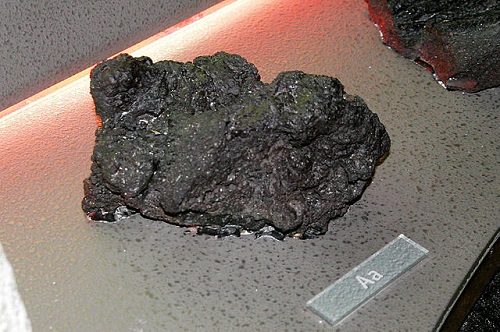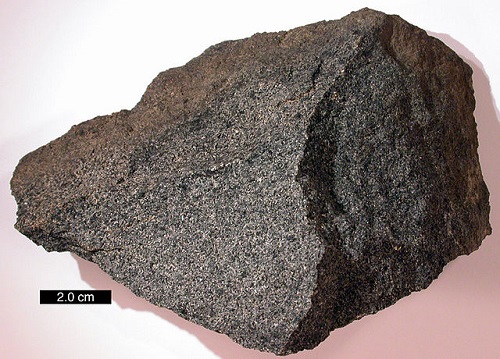Difference between Volcanic Rocks and Plutonic Rocks
What is Volcanic rocks?
Volcanic rocks are igneous rocks which form from lava, molten rock which has been thrust out of a volcano onto the surface of a rocky body such as an asteroid, planet, or dwarf planet. Volcanic rocks are fine-grained and are found on most terrestrial planetary bodies in our solar system.
Formation of volcanic rocks
Volcanic rocks form on the surface of a planet from molten rock after it has been ejected or extruded out of a volcano, a point in the crust which has been ruptured due to the pressure of upwelling molten rock. When molten rock flows on Earth’s surface, it is called lava. As the lava cools and hardens, mineral crystals will begin to form. The Crystals will continue to grow as long as there is still lava, so that the longer a lava takes to solidify, the larger the crystals will be in the resulting rock. Since volcanic rocks tend to form quickly and have little time to cool, the crystals within them tend to be very small, making volcanic rocks characteristically fine-grained.
Types of volcanic rocks
Mafic vs felsic
Igneous rocks can be classified in several ways including based on their chemical and mineralogical composition. Rocks that contain minerals with higher amounts of heavy elements such as iron and magnesium are considered mafic while rocks which have high silica content and minerals rich in lighter elements such as alkali feldspar are considered felsic. There are also rocks which are intermediate between felsic and mafic.
Basalt is a ubiquitous mafic volcanic rock. It forms in all active tectonic settings, but it often forms from lava originating from volcanoes that occur in continental rift basins, mid-oceanic ridges, and oceanic island arcs. Basalt also composes most of the surface rock of terrestrial planets and large asteroids. This makes it one of the most common, if not the most common, rock in the solar system.
An example of felsic volcanic rock is rhyolite which commonly forms at continental arcs. Rhyolite-forming lava tends to be more viscous and will occur alongside more explosive volcanic eruptions than those associated with basalt-forming mafic lavas. Andesite is the intermediate between basalt and rhyolite in terms of its chemical composition. One place where andesites are found is at an oceanic island arc.
What is Plutonic rocks?
Plutonic rocks are igneous rocks which form from subterranean chambers of molten rock or magma. Plutonic rocks make up the base of continental crust as well as oceanic crust. Their slow rate of formation causes them to be coarse grained since there is plenty of time for large crystals to form before the magma solidifies into rock. They also tend to be very long-lasting. Some of the oldest rocks on Earth are plutonic rocks.
Formation of plutonic rocks
Plutonic rocks form beneath the surface of differentiated planets and large asteroids. They originate from pockets of magma within the crust that can intrude into other rocks. When a large body of molten rock beneath the surface solidifies, it is called a pluton.
Types of plutonic rocks
Plutonic rocks can be classified based on their composition. A common type of mafic plutonic rock is gabbro. Gabbro commonly forms at mid-oceanic ridges. It can also form wherever there is an especially mafic magma, such as the oceans of molten rock which once existed on the Moon after the large impacts that formed the lunar maria. Beneath the abyssal plain and slopes of the mid-oceanic ridges, it composes the primary bedrock.
Granite is a felsic plutonic rock composing the base of most of the continental crust. Mineralogically, granite contains quartz, various feldspars, and micas. Although there are many rocks that resemble granite, they are not all true granites. Thus, plutonic rocks that are compositionally similar to granite but not identical are referred to as granitoids. Diorite is the compositional intermediate between granite and gabbro. In addition to true diorites, there are granodiorites which are rock units that are still intermediate but more felsic than mafic.
Similarities between volcanic and plutonic rocks
Volcanic and plutonic rocks are both igneous, meaning that they form from molten rock becoming solidified. They can also both be classified based on of their chemical and mineralogical composition. They also both form in geologically active zones such as subduction zones, rift valleys, and mid-oceanic ridges.
Differences between volcanic and plutonic rocks
Although there are many similarities between volcanic and plutonic rocks, there are also noticeable differences which include the following.
- Volcanic rocks are fine grained whereas plutonic rocks tend to be coarse grained
- Volcanic rocks form above the surface while plutonic rocks form beneath the surface.
- Volcanic rocks form rapidly in geological terms, in a few days at the most, whereas plutonic rocks can take thousands to millions of years to form because it takes much longer for rock beneath the surface to cool down than rock exposed to the atmosphere.
Volcanic rocks vs. plutonic rocks
| Volcanic rocks | Plutonic rocks |
| Fine-grained | Coarse-grained |
| Forms at planet’s surface from lava | Forms beneath the surface from magma |
| Forms rapidly | Forms slowly |
Summary of Volcanic rocks vs. Plutonic rocks
Volcanic rocks are igneous rocks that form at the surface of a planetary body from lava extruding out of volcanoes. They are fine-grained and can be classified based on composition. The most common type of volcanic rock is basalt. Plutonic rocks are igneous rocks that form beneath the surface from solidified magma which once formed subterranean chambers of molten rock. They are found mostly in Earth’s crust though there are some cases of them being found in meteorites and other extraterrestrial bodies. Like volcanic rocks, plutonic rocks can be classified on the basis of chemical and mineralogical composition. They are also alike in that they occur at geologically active zones. Volcanic rocks and plutonic rocks differ mainly in that volcanic rocks form at the surface of a planet whereas plutonic rocks form beneath the surface. Plutonic rocks are also coarser grained, being made of large interlocking crystals whereas volcanic rocks are more fine-grained. Volcanic rocks also form quite rapidly whereas the formation of plutonic rocks is much slower.
- Difference Between Environmental Performance Index and Development - November 24, 2023
- Difference Between Environmental Intervention and Development - November 8, 2023
- Difference Between Eco Efficiency and Eco Effectiveness - September 18, 2023
Search DifferenceBetween.net :
Leave a Response
References :
[0]Koeberl, Christian, Gero Kurat, and Franz Brandstätter. "Gabbroic lunar mare meteorites Asuka- 881757 (Asuka-31) and Yamato-793169: Geochemical and mineralogical study." Antarctic Meteorite Research 6 (1993): 14.
[1]Best, Myron G. Igneous and metamorphic petrology. John Wiley & Sons, 2013.
[2]Carter, J., and F. Poulet. "Ancient plutonic processes on Mars inferred from the detection of possible anorthositic terrains." Nature Geoscience 6.12 (2013): 1008-1012.
[3]"Image Credit: https://commons.wikimedia.org/wiki/File:Aa_volcanic_rock.jpg"
[4]"Image Credit: https://commons.wikimedia.org/wiki/File:GabbroRockCreek1.jpg"


